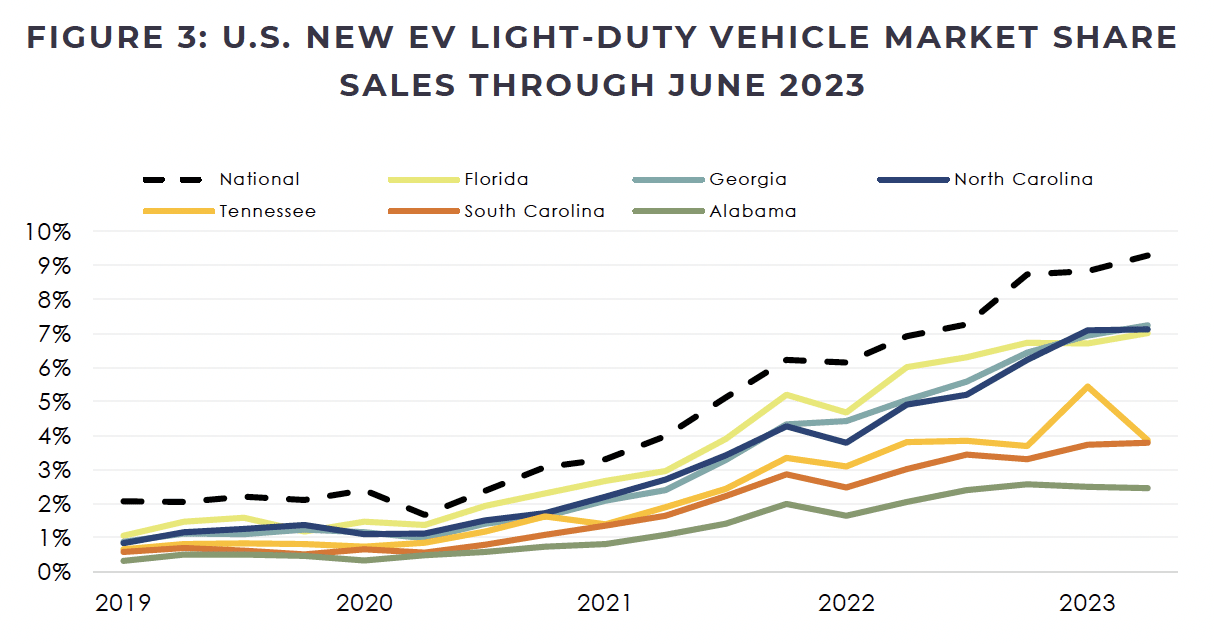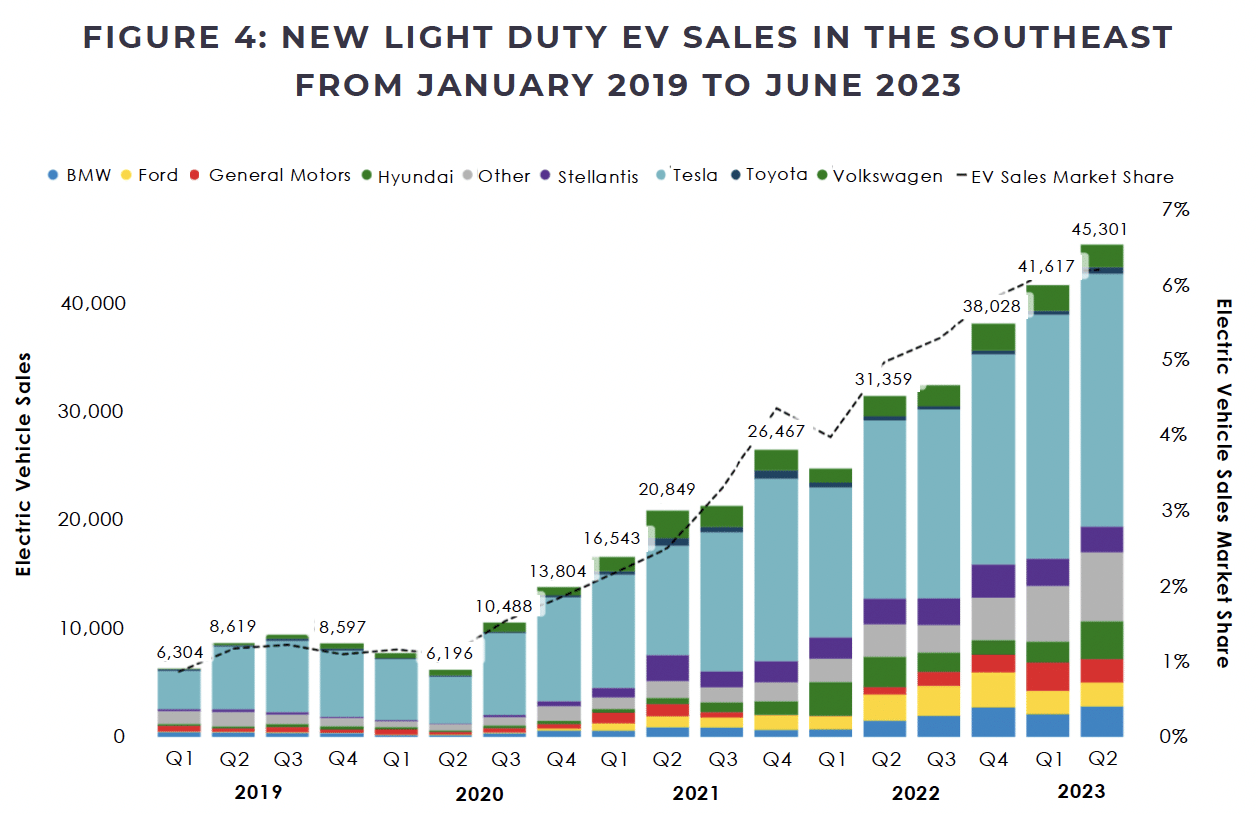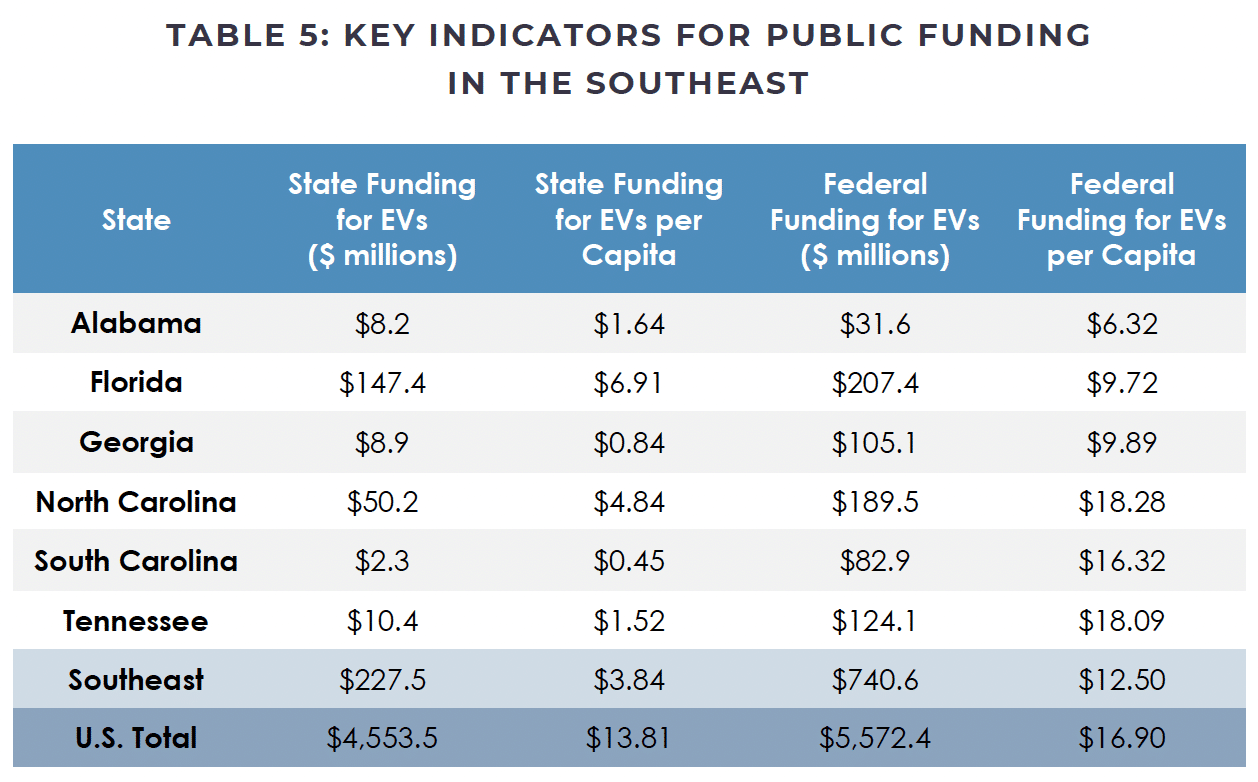Our fourth annual "Transportation Electrification in the Southeast" report unpacks market trends and policy levers underpinning growth in electric car, truck and bus adoption, including skyrocketing investments in manufacturing and job growth.
Stan Cross | September 6, 2023 | Clean Transportation, Electric Vehicles, Energy Policy, UtilitiesDrive through the major population centers across the Southeast United States today, and you’ll see an increasing number of both electric vehicles (EVs) on the roads and charging stations scattered in parking lots. You might see kids being picked up by an electric school bus, or riders hopping on an electric transit bus to get across the city. Drive through the region’s rural landscapes, and the number of EVs decreases, while massive EV and battery manufacturing sites rise out of fields and forests.
The Southeast’s EV market is complex and paradoxical. Our region has captured 40% of the nation’s EV assembly, EV parts, EV charging infrastructure, battery manufacturing, and battery recycling investments, and 35% of anticipated manufacturing jobs (totaling over 65,000). The Southeast has emerged as an EV and battery manufacturing powerhouse. And, though lagging behind national averages, light-duty passenger EV sales grew 50% over the past twelve months, and charging station deployment grew 66%.
Yet, the policy environment remains hostile in many states. For example, Alabama and Georgia have some of the nation’s highest EV road-use taxes; Alabama, Georgia, North Carolina, and South Carolina limit or ban EV manufacturers from selling or servicing their vehicles directly to consumers, including vehicles manufactured in those states; Georgia legislators imposed a new tax on the sale of electricity at EV charging stations; and Florida’s Governor vetoed a near-unanimous bipartisan bill that would have saved taxpayers money by prioritizing EVs for state and local government fleets.
In the “Transportation Electrification in the Southeast” fourth annual report, the Southern Alliance for Clean Energy and Atlas Public Policy highlight the data behind these complex market dynamics to provide context, showcase trends, and spotlight actions accelerating or slowing down EV adoption.

Read the Report Watch the Webinar View State Pages
Manufacturing Employment and Investment
The Southeast has emerged as a leading hub for EV manufacturing and jobs, with anticipated jobs totaling 65,242. Georgia leads the nation in anticipated EV manufacturing jobs, and the Southeast is home to four of the top eight states in the country—Georgia, Tennessee, North Carolina, and South Carolina.

Anticipated EV manufacturing jobs in the Southeast grew 56% over the past 12 months, as manufacturing investments grew 97%. This 12-month growth was driven by Hyundai in Georgia, which committed $4.3 billion in battery manufacturing investments in partnership with LG Energy Solutions, and Toyota in North Carolina, which expanded its committed battery manufacturing investments to $5.9 billion. With the federal Inflation Reduction Act (IRA) injecting billions of dollars into America’s clean energy economy, the Southeast is well-positioned for continued manufacturing and job growth.
EV Market Share and Sales
One of the best ways to track EV market momentum across states is to look at the market share of light-duty passenger EVs. Market share is the percentage EVs make up of all new car sales. The trend lines for all Southeast states are upward, though at different trajectories, and at the same time every state in our region continues to lag behind the national average. Georgia, Florida, and North Carolina lead the region with market shares in Q2 above 7%, double where these states were two years ago. If that doubling every two years continues, those states would see over 50% EV market share by 2030.

Market share is influenced by demographics (including the concentration of early adopter consumers), supportive or undermining public policies, and the presence of electric utility programs such as charging station rebates and discounted electricity rates. Market share is also a self-fulfilling prophecy; the more EVs on the road and in neighbors’ driveways, the more consumers are exposed to the technology and likely to consider buying one. Plus, for EV charging station companies, where the EVs are is where the business opportunity lies, and therefore where infrastructure investments are made, further supporting EV ownership in those areas.
Looking at the raw new EV sales numbers, the Southeast continues to reach new highs. Cumulative new EV sales in the Southeast grew 50% from July 2022 to June 2023, from 312,316 vehicles to 469,602 vehicles. Though Telsa still dominates the market, an increasing percentage of new EV sales are coming from legacy automakers.

Charging Deployment
In the past 12 months, the Southeast saw continued progress in deploying EV chargers. Regional DC Fast Charger (DCFC) ports now total 4,401 after a 60% increase year over year, and the region now boasts 15,036 public Level 2 charging ports, a 69% increase year over year. Though all Southeast states lag behind average national charging station deployment numbers, Georgia, Florida, North Carolina, and South Carolina are all trending in line with the national growth curve.
This DCFC deployment momentum is vital as states prepare to release nearly $680 million in National EV Infrastructure (NEVI) Program funds to scale DCFC every 50 miles along the region’s primary travel corridors. NEVI comes out of the Bipartisan Infrastructure Bill (BIL) and represents the most significant public investment in EV charging ever made. Current momentum indicates increased readiness of EV infrastructure manufacturers and installers to meet the demand NEVI will stimulate.

Utility Investments
Utilities represent an essential source of funding for the EV transition through direct infrastructure deployment, charger rebates, charging-as-a-service programs, make-ready infrastructure investments, supportive EV electricity rates, and funding to support vehicles such as electric school buses. The investor-owned utilities in our region significantly trail their national peers in dollars per customer invested in supporting the EV transition: the national average is $75 invested in transportation electrification per customer, whereas the Southeastern utilities range from $41 to just $3 per customer. Our region, which makes up 18% of the nation’s population, represents just 7% of all approved utility investments nationally.

“Drilling down into equity, the Southeast has seen low levels of identified equity-focused investments in transportation electrification from investor-owned utilities. From July 1, 2022, through June 2023, around $6 million in the region was approved for underserved communities, or 10% of all approved investments within the past 12 months. For reference, over the same period, 54% of utility transportation electrification filings were classified as equity investments nationally.”
Public Funding
Southeast lawmakers have allocated very few state dollars to support transportation electrification outside incentive packages to entice businesses to locate and expand. However, states have accessed significant federal funding and leveraged VW Settlement funds to enable EV infrastructure deployment and electric school and transit bus purchases. Over the past 12 months, the region has accessed federal funds totaling $234 million for electric transit buses, $172 million for electric school buses, and $3 million in EV-related research and development grants, and awarded $169 million in VW Settlement funds. The total amount of federal transportation electrification funding allocated to date is $741 million, which could be dwarfed over the coming years if the region is successful at drawing down the massive amount of funding being made available through a growing list of BIL and Inflation Reduction Act (IRA) programs.

Conclusion
Electric vehicle sales are on the rise, expanding significantly across the Southeast. The region continues to lead nationally in new battery production and EV manufacturing investments, with many new billion-dollar announcements throughout the Carolinas, Georgia, and Tennessee. Meanwhile, the first round of NEVI and Community Fueling Infrastructure (CFI) grant funding will inject hundreds of millions of dollars for EV charging infrastructure buildout in the Southeast. Other federal funding from BIL and IRA will continue to drive private sector investments in EV, battery, and supply chain manufacturing and jobs, provide vehicle tax credits to support consumer and fleet EV purchases, increase charging station deployments, and more. But while the market and funding opportunities have expanded, supportive policies have yet to keep pace.
The speed at which electric car, truck, and bus adoption will grow in the Southeast and the equitable access to the benefits of the growth depends largely on how the work of policymakers at the state and local level complements and enhances investments from industry and the federal government. More action now will put Southeast residents and fleet operators in the driver’s seat on their way to improved public health, a cleaner environment, and a growing economy.
The Southern Alliance for Clean Energy’s Electrify the South program leverages research, advocacy, and outreach to accelerate the equitable transition to electric transportation across the Southeast. Visit ElectrifytheSouth.org to learn more and connect with us.